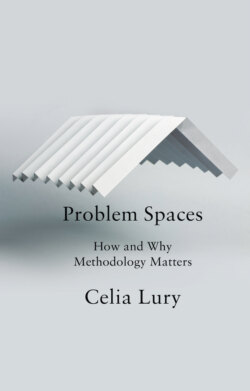Читать книгу Problem Spaces - Celia Lury - Страница 7
So, what is a problem space?
ОглавлениеIn established methodological terms, a problem space is a representation of a problem in terms of relations between three components: givens, goals and operators. ‘Givens’ are the facts or information that describe the problem; ‘goals’ are the desired end state of the problem – what the knower wants to know; and ‘operators’ are the actions to be performed in reaching the desired goals. In many methodological discussions, the relation between these three components is assumed to be stable and relatively straightforward. Once givens and goals are assessed, operators – concepts and methods – can be identified and implemented, problems can be defined, analysed and solved in sequential steps: the problem space contains the problem. But such an approach presumes that we know the problem before we start investigating, and that it remains the same as it is investigated. And this is very often not the case: the problem is a problem, becomes a problem as it is investigated. If we take seriously the becoming of a problem then we cannot stick with a container conception of a problem space. Instead, we should pay attention to the constantly changing relations between givens, goals and operators in which a problem is transformed.1 This requires an understanding of a problem space as a space of methodological potential.
To develop this understanding and consider how this potential may be realized to ‘test the present’ (Stengers 2019), the book outlines a compositional methodology. The distinctiveness of this methodology comes from an emphasis on the vocabulary of composition,2 a term that Whitehead employs in the quotation above, but whose everyday definition is ‘the action of putting things together’. Here it refers to the processes, the activities with which the givens, goals and operators of a problem space are put together. When the term composition is used in the visual and performing arts the emphasis is on the creativity of this action of putting things together. It is used here – in a way that it is hoped will be of interest to disciplinary and interdisciplinary researchers of all kinds – to describe a methodology in which the focus is on the ways in which a problem is put together, how it is formed and transformed, inventively (Lury and Wakeford 2012). In this process of putting a problem together, of forming and transforming, the compulsion of composition does not come from either inside or outside the problem; the problem is not acted on in a space but emerges across a problem space, from with-in and out-with.
For compositional methodology, an understanding of a problem as a form of process is fundamental, where form consists in both the problem and its limits or constraints.3 To explicate this understanding of form, let me introduce a series of works by the artist Dorothea Rockburne: Drawing Which Makes Itself (1972–3). In these works, a double-sided piece of carbon paper, which I invite you to consider as analogous to a phenomenon or situation becoming a problem, is held against a wall or a floor, folded and rotated, with the edges or limits of the space it makes in these activities scored through the paper onto the wall or floor. The activities (the methods) of folding, rotating and scoring move the paper (the problem) into and through another dimension in a process of transformation. The art critic Rosalind Krauss says of these works:
The act of scoring simultaneously deposits carbon onto the wall surface and underlines the fold of the paper itself. The resultant lines or marks are read with a striking ambivalence, for they are both on the wall and yet they are retained within the carbon paper that had been flipped into a new position. … one confronts works in which the lines [that are ‘out-with’ the paper] arise from information that is ‘[with]in’ the paper. (2010: 221)
Figure 1 Installation piece: Arc
Source: Dorothea Rockburne (1973) © ARS, NY and DACS, London 2020
Acting methodically on the properties of a situation becoming a problem (trans)forms the problem. The limits of the problem are with-in and out-with it: they do not contain it, but, rather, express or encapsulate it.
The material-semiotic properties of the double-sided carbon paper mean that some acts – some methods – have expressive effects; it is a drawing that draws itself. At the same time, not only do the material-semiotic properties of the paper – the problem – have methodological potential (to be folded, to be scored, to be rotated), so too does the context in which the work is (re-)presented matter. Rockburne says the context should ‘represent’ the art. To do so requires that the context be (re)active:
I was very interested in the fact that the whole room should represent the art. I painted the walls with the brightest white paint you could find. As people walked into the room, their footprints became part of the drawing. (https://www.khanacademy.org/humanities/art-1010/minimalism-earthworks/v/rockburne-drawing)
Inspired by this work, the concept of a problem space put forward here is that it is a space of methodological potential that is with-in and out-with the ongoing transformation of a problem. The potential is realized in a methodology that, rather than responding only to the initial presentation of a problem, composes the problem again and again.
